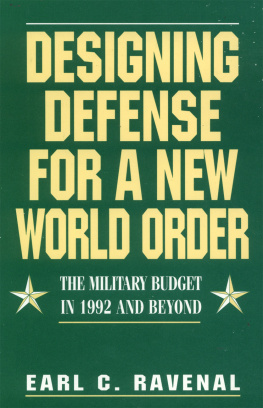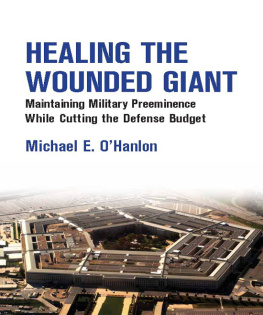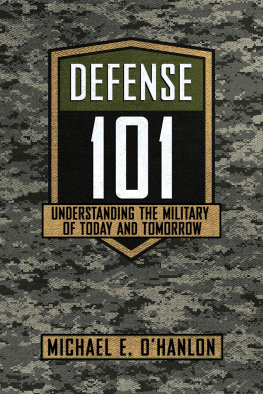__________________________________________________
DESIGNING
DEFENSE
FOR A NEW
WORLD ORDER
THE MILITARY BUDGET IN 1992 AND BEYOND
__________________________________________________
__________________________________________________
DESIGNING
DEFENSE
FOR A NEW
WORLD ORDER
THE MILITARY BUDGET IN 1992 AND BEYOND
__________________________________________________
EARL C. RAVENAL
__________________________________________________
INSTITUTE
Washington D.C.
Copyright 1991 by Earl C. Ravenal.
All rights reserved.
Library of Congress Cataloging-in-Publication Data
Ravenal, Earl C.
Designing defense for a new world order: the military budget in 1992 and beyond / by Earl C. Ravenal.
p. cm.
Includes bibliographical references.
ISBN 0-932790-86-0: $9.95.
United States-Military policy. 2. United States-Armed Forces-Appropriations and expenditures. 3. United States-Foreign relations-1989- I. Title.
Cover design by Colin Moore.
Printed in the United States of America.
C ATO I NSTITUTE
224 Second Street, S.E.
Washington, D.C. 20003
The Bush 1992 Defense Program:
"Two Times Three-Quarter Wars"
Global intervention-adopting every country's threats-is the strategic premise of the Bush administration's post-Persian Gulf defense program for fiscal year 1992. The Bush administration's 1992 defense program is not just a bunch of numbers. It incorporates two main ideas:
- It continues to take savings, measured against the "original" defense program enunciated by the incoming Bush administration on April 25, 1989, accomplishing a projected "peace dividend," through FY 1996, of $397 billion.
- It transcends the cold-war "bipolar" military orientation, committed to containing Soviet and other communist expansion; yet it harbors a substitute global interventionist design, as well as a residual commitment to present allies.
Defense budgets express, and must be measured against, some larger concept of national security and, beyond that, some foreign policy and view of the world. Thus, this defense budget represents the Bush administration's projection of the post-Persian Gulf world and the political-military role of the United States in that world. It incorporates an inchoate "Bush Doctrine" -which seems to be that the United States must protect a scheme of world order, a sort of combined "unipolar world" and regime of collective security, and that, specifically, the United States has extensive interests in various regions that may require military intervention.
It is only fair to observe that the Bush administration is planning a significant reduction of general purpose forces (measured by the decrease from 21 land divisions at the start of 1990 to 17 land divisions at the end of 1992, (and beyond that, to 15 land divisions in 1995). More important, in terms of this administration's defensive purposes, is a restructuring of the regional attributions of forces (which must be inferred from various indications in the secretary of defense's 1992 "posture statement"). In my analysis, ground forces (and along with them, roughly proportional segments of tactical air and surface naval forces) primarily allocated to a European contingency decrease from the FY 1990 defense program's 11 2/3 divisions to the FY 1992 program's 7 1/3 divisions. Correspondingly, ground forces dedicated to an "other regional" (other than Europe or East Asia) contingency increase from the 5 2/3 divisions of FY 1990 to the 6 2/3 divisions of FY 1992. (Ground forces identified for East Asia decrease moderately from 3 2/3 to 3 divisions.)
What this reflects is the arrival of the post-cold war world, or the implementation of Bush's "new world order." This is more than a mere slogan; it has-at least now-a tangible, operational concomitant in our force structure and defense budget. In effect (without quite putting it in such terms), Bush is moving from Reagan's "H2 (ample) wars"-which followed Carter's "1 1/2 (NATO-weighted) wars" and, before that, Nixon's "1 1/2 wars," which radically shifted from Johnson's and Kennedy's "2 1/2 wars"-to a new force-sizing concept that could be called "two times three-quarter wars," since the possible second war (such as that in the Persian Gulf) might be as large as the (now scaled-down) European war.
One thing is clear about the new world order: it is not self-enforcing. It depends on American power. To address the possible simultaneity of conflicts, the United States must have fairly large and redundant forces. To confront a variety of possible adversaries, it will need a range of modern, capable forces, in turn requiring advanced technology and considerable research and development. To cope with initial defense (not just counterattack), it must have ready, deployed or deployable, units and forward logistical bases and pre-positioned equipment on land and sea; and for this, it needs allies that will have to be favored in various military, diplomatic, and economic ways.
Collective security does not mean net burden shifting. Rather, it creates liabilities (commitments to allies, military and economic assistance) at the same rate as assets (bases, overflight, cooperative forces, some financial contributions). In a sense, the United States is acquiring every nation's enemies.
True, without a permanent adversary in the form of the Soviet Union, we might decline some invitations to conflict. But Bush's 1992 defense program is a prescription that is still expensive and potentially escalatory. It is expressive not so much of a state of affairs "beyond containment" as of a globalization of containment. It universalizes threats, and it hopes to collectivize the military response, always under American direction. America remains the world's policeman-even more so, since it undertakes to protect against a full spectrum of challenges in any and all regions.
Some important details of America's geopolitical situation hinge on the regional alignment that will follow the gulf war. Yet the war illustrates, rather than alters, a more general state of affairs that was already shaping up in the wake of the cold war, before Saddam Hussein's invasion of Kuwait on August 2, 1990. The events in the Persian Gulf must be read as evidence of the unfolding future of the international system and particularly as an object lesson in the propriety of American military intervention in the impending new system.
All the more reason, then, to step back from the pressing and poignant events of the present and gain some perspective-even to the point of abstraction-on the situation of the United States in the world. We should be looking, not for specific guidance on particular deployments or individual weapons systems, but for general principles of orientation and organization that are appropriate to the emerging state of affairs. And we should be trying to discern, not particular threats-specific things against which the United States must prepare, in detail, to defend-but rather the kind of world, with its characteristic disturbances, that we will be facing as far out as the horizon of 15 to 30 years, so that we may form some judgment about whether such disturbances will constitute integral threats to American society.












